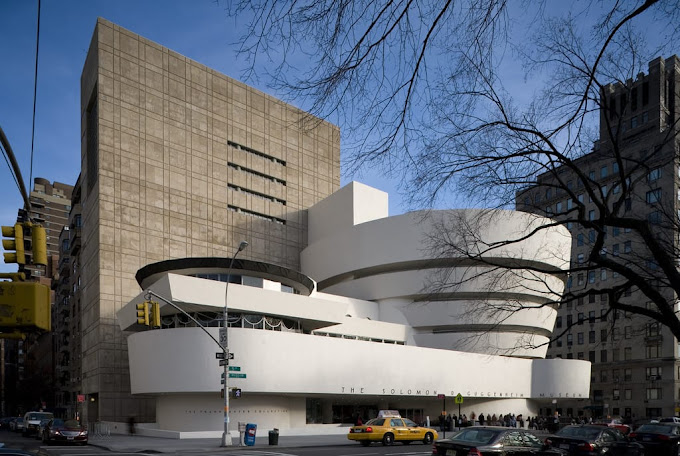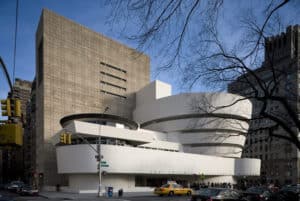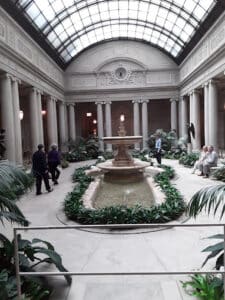Solomon R. Guggenheim Museum:
Solomon R. Guggenheim Museum New York, often simply referred to as the Guggenheim, is an iconic institution located on New York City’s Fifth Avenue. This world-renowned museum is not only celebrated for its exceptional collection of modern and contemporary art but also for its groundbreaking architecture. Designed by the legendary Solomon r. Guggenheim museum architect Frank Lloyd Wright, the Guggenheim Museum stands as a testament to the harmonious fusion of art and architecture. In this article, we will explore the rich history, architectural innovation, and artistic significance of the Solomon R. Guggenheim Museum.
A Visionary’s Dream:
The story of the Guggenheim Museum begins with the vision of one man, Solomon R. Guggenheim, an art collector and philanthropist with a passion for modern art. Guggenheim aimed to establish a museum that would showcase avant-garde art and provide a platform for artists to push the boundaries of creativity. His dream materialized in the form of the Guggenheim Museum, which opened its doors to the public on October 21, 1959, six months after his passing.
Solomon R. Guggenheim Museum Architecture:
Frank Lloyd Wright’s design for the Solomon R. Guggenheim Museum is a masterpiece of architectural innovation and artistic expression. It incorporates a variety of geometric motifs, including squares, circles, rectangles, triangles, and lozenges, creating a visually dynamic and harmonious structure.
The primary massing of the building consists of two spiraling structures: the six-story main gallery to the south and the smaller “monitor” to the north. These structures are interconnected by a “bridge” on the second story, creating a continuous and flowing space for the display of art. The ten-story rectangular annex, situated to the northeast of the spiraling structures, complements the overall composition when viewed from Central Park.
One of the most striking aspects of Wright’s design is his emphasis on the “inherent plasticity of organic forms in architecture.” This approach reflects his belief in the integration of architecture with the natural world. While the design incorporates geometric shapes, it also draws inspiration from nature, blending the man-made and organic elements seamlessly.
Wright’s design reveals his unique interpretation of modernist architecture’s rigid geometry. He sought to infuse his work with a sense of organic progress and symbolism. For example, he attributed specific meanings to the building’s shapes: the circle symbolizing infinity, the triangle representing structural unity, the spiral signifying organic progress, and the square denoting integrity.
Throughout the museum, one can observe a consistent and deliberate use of these geometric forms. Oval-shaped columns echo the geometry of the central fountain, creating a sense of visual continuity. Circular motifs are prevalent, from the main gallery’s spiral ramp to the circular inlays in the museum’s terrazzo floors, contributing to a sense of coherence and unity in the design.
In essence, Frank Lloyd Wright’s design for the Guggenheim Museum is a celebration of both the mathematical precision of geometric forms and the organic beauty of nature. It’s a testament to his ability to transcend conventional architectural norms, creating a space that not only houses art but also serves as a work of art in its own right. The Guggenheim Museum remains a remarkable embodiment of Wright’s architectural vision and continues to captivate visitors with its unique blend of form, function, and symbolism.
A Home for Modern Art:
The Guggenheim Museum’s collection is a treasure trove of modern and contemporary art. It boasts an extensive array of works by pioneering artists such as Pablo Picasso, Wassily Kandinsky, Jackson Pollock, and Vincent van Gogh, among others. The museum’s commitment to showcasing cutting-edge and experimental art forms aligns perfectly with its unconventional architecture.
Throughout its history, the Guggenheim has hosted groundbreaking exhibitions and retrospectives that have pushed the boundaries of art. Its dedication to innovation has earned it a revered place in the art world and has contributed significantly to the development and recognition of contemporary art.
Solomon R. Guggenheim Museum stands as a testament to the enduring power of art and architecture to inspire, challenge, and transform. From its visionary founder, Solomon R. Guggenheim, to the architectural genius of Frank Lloyd Wright, the Guggenheim has been a beacon for modern and contemporary art. Its spiraling form and ever-evolving collection continue to captivate and inspire art lovers and visitors from around the world. As we marvel at the Guggenheim’s fusion of art and architecture, we are reminded that it is not merely a museum but a living testament to the boundless possibilities of human creativity.
What are some famous artworks at the Guggenheim?
Solomon R. Guggenheim Museum is renowned for its collection of modern and contemporary art, featuring works by some of the most influential artists in the art world. Here are a few famous artworks and artists represented in the Guggenheim’s collection:
Pablo Picasso’s “Woman Ironing” (1904): This early Picasso work is a prime example of his Blue Period, characterized by melancholic and somber subjects. “Woman Ironing” is a poignant portrayal of the hardships of the working class.
Wassily Kandinsky’s “Composition 8” (1923): Kandinsky, a pioneer of abstract art, is well-represented at the Guggenheim. “Composition 8” is one of his notable works, characterized by vibrant colors, geometric shapes, and non-representational forms.
Jackson Pollock’s “Autumn Rhythm (Number 30)” (1950): Pollock’s iconic “drip paintings” revolutionized abstract expressionism. “Autumn Rhythm” is a masterful example of his technique, with rhythmic, swirling lines of paint that seem to dance across the canvas.
Vincent van Gogh’s “The Yellow House” (1888): Although the Guggenheim’s collection of van Gogh’s works is not extensive, “The Yellow House” is a notable piece. It depicts the house in Arles, France, where van Gogh lived and worked during a prolific period.
Marc Chagall’s “I and the Village” (1911): Chagall’s dreamlike and imaginative style is exemplified in “I and the Village.” This painting combines elements from his childhood in Russia with modernist and Cubist influences.
Kazimir Malevich’s “Suprematist Composition: White on White” (1918): Malevich was a leading figure in the Suprematist movement, and this work is an iconic representation of his exploration of geometric abstraction, consisting of white shapes on a white background.
Yayoi Kusama’s “Infinity Mirrored Room – The Souls of Millions of Light Years Away” (2013): Kusama’s immersive installation is a contemporary favorite. It features mirrored walls, LED lights, and suspended, reflective orbs, creating a mesmerizing and seemingly infinite space.
Jean-Michel Basquiat’s “Untitled” (1981): Basquiat’s expressive and graffiti-inspired art has gained immense popularity. “Untitled” showcases his distinctive style, blending text and imagery in a way that addresses themes of race, identity, and society.
Robert Mapplethorpe’s Photographs: The Guggenheim holds a significant collection of Robert Mapplethorpe’s photographs. His striking and sometimes controversial images explore themes of sexuality, identity, and beauty.
Louise Bourgeois’ Sculptures: Louise Bourgeois is known for her thought-provoking sculptures, many of which explore themes of identity, family, and trauma. Her spider sculptures, such as “Maman,” are some of her most recognizable works.
These are just a few examples of the remarkable artworks you can encounter at the Guggenheim Museum. The museum’s collection is dynamic, and it regularly hosts special exhibitions, ensuring that visitors can experience a wide range of artistic expressions and styles.
Solomon R. Guggenheim Museum Hours:
The opening hours are as follows
Sunday to Friday: 11 am to 6 pm
Saturday: 11 am to 8 pm
Solomon R. Guggenheim Museum Tickets
guggenheim museum tickets price
Adults: $16 (usually $30)
Students and Seniors 65+ (with ID): $12 (usually $19)
Visitors with disabilities (carepartners free): $12 (usually $19)
Children under 12 years old: Free
Members: Free
Solomon R. Guggenheim Museum Photos:




